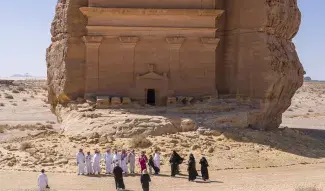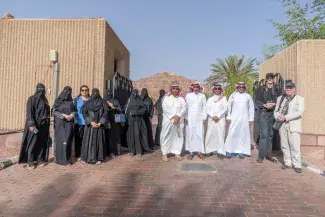
Cultural Heritage: a Story of Connections
Franco-Saudi scientific cooperation to spread knowledge in AlUla (Saudi Arabia).
The Jaussen and Savignac Programme, a result of a scientific cooperation agreement between The Royal Commission for AlUla and Université Paris 1 Panthéon-Sorbonne includes both a search and a training component as well as spreading knowledge.
This is the frame in which Professor François Giligny, Cyrille Galinand (archaeologist) of Paris 1 Panthéon-Sorbonne University along with Salomé Sepeau, cultural mediator and photograph, conducted workshops around archaeological heritage and its transmission for the local population of AlUla (Saudi Arabia) last May (2025/19-24).
Quite well-informed audience, the attendees (tourism professionals, primary and middle school teachers and AlUla inhabitants) are already very well aware of their cultural heritage’ value: so why offer such workshops?
A local history that is now UNESCO’s World Heritage
AlUla’s history is an integral part of the participants' lives where archaeological remains, stories, legends and family histories intertwine, forged over the years and generations: this multi-millenial heritage was, even then, the childhood playground for many of them, their parents, grandparents… In fact they are the last generation of the indigenous population who lived alongside these vestiges: it was part of their familiar living environment, where family gatherings took place, evening or non-working days walks etc.
In 2008, the archaeological site of Hegra (al-Hijr / Madā ͐ in Ṣāliḥ) in AlUla is one of the first place in Saudi Arabia to be enlisted on UNESCO World Heritage List not only but also for its impressive monumental funeral stone-cut architecture and monuments from the Nabateen period: this wonderful heritage is now protected and opened up to the whole world. At the same time it is restricted for conservation reasons. Local population must therefore learn how to reclaim the site and reconnect with its local monumental archaeological history in a different way.
It was in this context that French academics gave these training workshops « designed to train educators and engage the local community in understanding the importance of preserving archaeological heritage » to quote The Royal Commission for AlUa.
Expertise and multi-faceted teaching methods
Equiped with maps, plans, 3D objects and mediation games, teachers from Paris 1 Panthéon-Sorbonne ran workshops focusing on three themes:
- What is archaeology?: from preliminary work of survey, to digging and post-excavation analysis, how a site is located and excavated ? How are artefacts processed to ensure they provide relevant information?
- How connecting people to archaeology and archaological sites? What can we learn about everyday life in ancient times from the objects and remains we find?
- How can we teach and pass on the value of this heritage? What are the strategy for passing on this cultural heritage ? What cultural mediation tools can be created on a modest budget?
Eager to learn, the participants welcomed the key to understanding their history with enthusiasm. They enjoyed the educational tools provided for passing on this remarkable heritage. The visits provided a new perspective on Hegra and Dadan sites, inspiring the reappropriation of new stories. They were also able to visit the museum’s storerooms where the artefact are preserved.
Finally, tools such as the game kit for cultural mediation and the presentation of 3D modelling and printing of archaeological objects offered new perspectives in terms of transmission: these media are in fact a good way of bringing to life objects from the distant past and making them relevant to us today.
Cultural heritage: a place of sharing and conviviality
During the discussions surrounding these workshops, François Giligny and Cyrille Galinand were particularly struked by the deep-rooted attachment of the local population to their cultural heritage. At the end of these few days, they understood its importance in even greater depth and detail: how proud they are to think that a monumental statue of an ancient Lihyanite king (5th-6th century B.C.) from Dadan is on loan from the Royal Commission for AlULa to the Musée du Louvre for 5 years. In a way, it is a part of themselves that can be seen in this exceptional museum.
The Saudis of AlUla were generous and welcoming. They took great joy in sharing their culture with the professors. Some of them even opened the doors to their small private museums, which contained treasures of art and popular traditions that the teachers had the chance to discover in a privileged way.

What a great week of cultural exchanges!
François Giligny, Cyrille Galinand and Salomé Sepeau all enjoyed a wonderful week of cultural exchange, during which they gave as much as they received.
At the end of this busy week (in a blazing sun at this time of year), some of the participants decided to undergo 3D modelling training, and even several volunteered for future excavation projects!
So thank you to the people of AlUla – we'll see you next year with sharp eyes and trowels in hand!
► To see the programme and photos from this week's workshops, click here.